Welcome to
McGraw-Hills
GMAT
Congratulations! Youve chosen the GMAT guide from Americas leading educational publisher. You probably know us from many of the textbooks you used in school or in college. Now were ready to help you take the next stepand get into the business school of your choice.
This book gives you everything you need to succeed on the test. Youll get in-depth instruction and review of every topic tested, tips and strategies for every question type, and plenty of practice exams to boost your test-taking confidence. Theres also a bonus section with information and expert advice about getting into a graduate business program, surviving business school, and launching your career. To get started, go to the following pages where youll find:
 How to Use This Book: Step-by-step instructions to help you get the most out of your test-prep program.
How to Use This Book: Step-by-step instructions to help you get the most out of your test-prep program.
 Your GMAT Action Plan: Learn how to make the best use of your preparation time.
Your GMAT Action Plan: Learn how to make the best use of your preparation time.
 Using the Free Online Practice Tests and Problem-Solving Videos: Log on to the companion website for additional test-taking practice and to view videos demonstrating the use of problem-solving strategies to answer GMAT questions.
Using the Free Online Practice Tests and Problem-Solving Videos: Log on to the companion website for additional test-taking practice and to view videos demonstrating the use of problem-solving strategies to answer GMAT questions.
 Important GMAT Information for International Test Takers: Find out everything you need to know if you live outside the United States and want to attend a U.S. business school.
Important GMAT Information for International Test Takers: Find out everything you need to know if you live outside the United States and want to attend a U.S. business school.
ABOUT McGRAW-HILL EDUCATION
This book has been created by a unit of McGraw-Hill Education, a division of The McGraw-Hill Companies. McGraw-Hill Education is a leading global provider of instructional, assessment, and reference materials in both print and digital form. McGraw-Hill Education has offices in 33 countries and publishes in more than 65 languages. With a broad range of products and servicesfrom traditional textbooks to the latest in online and multimedia learningwe engage, stimulate, and empower students and professionals of all ages, helping them meet the increasing challenges of the 21st century knowledge economy.

How to Use This Book
Follow the steps below to work your way through this book or develop your own personalized action plan (see following).

1 Learn About the GMAT Test Format
Dont skip the introduction; in it youll meet the GMAT and learn about the structure of the test, including the different test sections, the number of questions in each section, and the section time limits. Youll also find valuable test-taking strategies and important information about how the test is scored.
2 Prepare for the Quantitative Section
. In each chapter there are plenty of GMAT practice questions to check your progress. To see demonstrations of GMAT problem-solving strategies, view the free videos on the companion website at MHPracticePlus.com/GMAT.
3 Prepare for the Verbal Section
focuses on reading comprehension portion of the test; use it to familiarize yourself with the format and question types youll encounter on this section of the test.
4 Get Ready for the Analytical Writing Assessment
contains information about how the writing assessment is scored as well as strategies and tips to help you maximize your score. Practice writing your essays under the most authentic conditions possible: use a computer and stick to the time limit.
5 Learn All About Integrated Reasoning
covers the GMATs unique integrated reasoning questions. Youll see many examples of this distinctive question type, which asks you to reach conclusions from data presented in varied formats. Youll also get the opportunity to sharpen your reasoning skills with practice problems.
6 Take the Practice Tests
Get ready for the actual exam by taking the GMAT practice tests online and in Part Six of this book. Try to simulate actual testing conditions. Youll gain experience with the test format, and youll learn to pace yourself so that you can earn your highest score.
BONUS: Beyond the GMAT
We know getting a good score on the GMAT isnt your ultimate goal; ).
Your GMAT Action Plan
To make the best use of your GMAT preparation time, youll need a personalized action plan thats based on your needs and the time you have available. This book has been designed for flexibility; you can work through it from cover to cover or you can move around from one chapter to another in the order you want based on your own priorities and needs. However, before you jump in, maximize the effectiveness of your preparation time by spending a few minutes to develop a realistic plan of action that focuses on the areas where you are weakest, takes into account the time you have, and provides the discipline you need to pace yourself and achieve your goals.
Components of a Good Preparation Strategy
Make sure your action plan includes all the areas you need to cover. There are three broad areas you need to consider in any well-rounded action plan to master the GMAT.
1. Knowledge and Skills
Youll need a combination of knowledge and skills to find the correct answers to GMAT questions. The first eleven chapters of this book give specific guidance on knowledge and skill areas required. Here is a broad summary:
 Math skills: Basic mathematics, algebra, geometry, probability, statistics, etc. The GMAT covers everything from fractions to permutations and combinations.
Math skills: Basic mathematics, algebra, geometry, probability, statistics, etc. The GMAT covers everything from fractions to permutations and combinations.
 Reading skills: Reading quickly, understanding what you read, scanning a passage for specific information, etc. Youll need to be able to quickly read various types of passages with a good comprehension of what you have read.
Reading skills: Reading quickly, understanding what you read, scanning a passage for specific information, etc. Youll need to be able to quickly read various types of passages with a good comprehension of what you have read.
 Analytical skills: Identifying issues, understanding how evidence is used to support or weaken an argument, recognizing inferences, finding inconsistencies, etc. The Analytical Writing Assessment and the Critical Reasoning and Integrated Reasoning sections of the test require sound analytical skills.
Analytical skills: Identifying issues, understanding how evidence is used to support or weaken an argument, recognizing inferences, finding inconsistencies, etc. The Analytical Writing Assessment and the Critical Reasoning and Integrated Reasoning sections of the test require sound analytical skills.
 Grammar skills: Word usage, sentence construction, punctuation, grammar, etc. There are more sentence correction questions in the GMAT Verbal section than any other kind of question.
Grammar skills: Word usage, sentence construction, punctuation, grammar, etc. There are more sentence correction questions in the GMAT Verbal section than any other kind of question.
 Writing skills: Paragraph construction, clarity, organization, transition, etc. The first half hour of the test requires a written essay, so youll need good writing skills to do well.
Writing skills: Paragraph construction, clarity, organization, transition, etc. The first half hour of the test requires a written essay, so youll need good writing skills to do well.
2. Pacing and Endurance
The GMAT is both a sprint and a marathon. You have less than two minutes, on average, for each Verbal question and barely two minutes for each Quantitative or Integrated Reasoning question, so it is essential to develop the ability to work through these questions quickly and efficiently. Speed is not enough; at nearly four hours in length, the GMAT requires that you have extraordinary mental stamina so that you can stay focused throughout the test. The best way to prepare yourself is to take practice tests observing strict time limits. There are practice tests included with this bookin the back of the book and online.


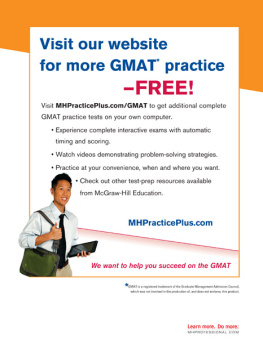

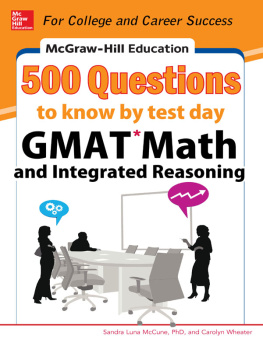
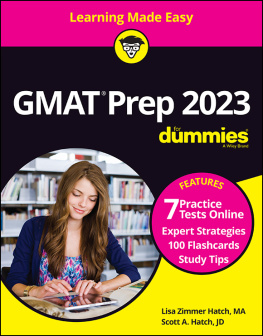
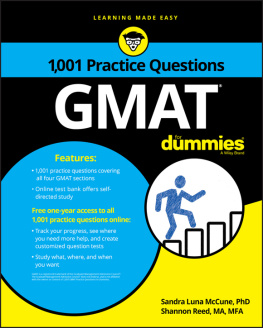
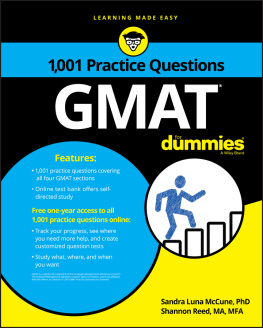
 How to Use This Book: Step-by-step instructions to help you get the most out of your test-prep program.
How to Use This Book: Step-by-step instructions to help you get the most out of your test-prep program.
